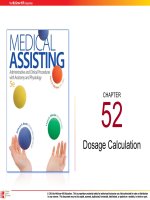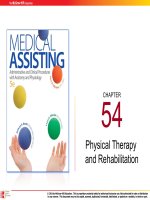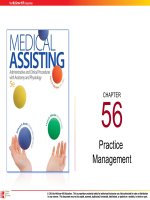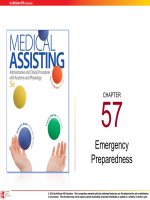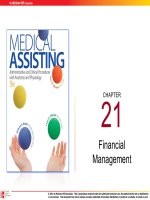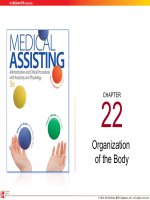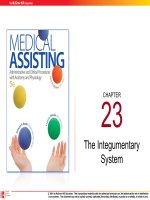Medical assisting Administrative and clinical procedures (5e) Chapter 30 The nervous system
Bạn đang xem bản rút gọn của tài liệu. Xem và tải ngay bản đầy đủ của tài liệu tại đây (1.1 MB, 57 trang )
CHAPTER
30
The Nervous
System
30-2
Learning Outcomes (cont.)
30.1 Describe the general functions of the
nervous system.
30.2 Summarize the structure of a neuron.
30.3 Explain the function of nerve impulses and
the role of synapses in their transmission.
30.4 Describe the structures and functions of the
central nervous system.
30-3
Learning Outcomes (cont.)
30.5 Compare the structures and functions of the
somatic and autonomic nervous systems in
the peripheral nervous system.
30.6 Recognize common tests that are performed
to determine neurologic disorders.
30.7 Describe the causes, signs and symptoms,
and treatments of various diseases and
disorders of the nervous system.
30-4
Introduction
• Highly complex system
• Controls and helps to
maintain balance in all
other organ systems
Disorders are numerous and often
difficult to diagnose and treat
30-5
General Functions of the Nervous System
• Central Nervous
System (CNS)
– Brain
– Spinal cord
• Peripheral
Nervous System
(PNS)
– Peripheral nerves
– Somatic nervous
system (SNS)
– Autonomic
nervous system
(ANS)
30-6
General Functions of the Nervous System
(cont.)
• Afferent nerves ~ sensory information
• Efferent nerves ~ impulses that allow for
movement or action
• Interneurons – interpreters between
afferent and efferent nerves
30-7
Apply Your Knowledge
Match the following:
ANSWER:
B Somatic nervous system
___
A. Motor nerves
C Autonomic nervous system B. Governs skeletal or voluntary
___
muscles
E Afferent nerves
___
systems
A
C. Governs respiratory and GI
___
D Efferent nerves
___ Interneurons
D. Go-betweens or interpreters
E. Sensory nerves
30-8
Neuron Structure
• Functional cells of
NS
• Transmit nerve
impulses to
– Other neurons
– Effectors
• Cannot divide
• Neuroglia
– Support cells for
neurons
– Astrocytes
– Microglia
– Oligodendrocytes
30-9
Neuron Structure (cont.)
• Neurons
– Cell body
• Nucleus and organelles
• Generates proteins and
energy
– Nerve fibers ~ extend
from cell body
30-10
Neuron Structure (cont.)
• Axons
– One per neuron
– Send nerve impulses away
from the cell body
• Dendrites
– One or more per neuron
– Receive nerve impulses
for the neuron
30-11
Neuron Structure (cont.)
• Schwann cells
– Wrap around axons
– Membranes contain myelin
• White matter – myelin sheath
• Gray matter – no myelin sheath
30-12
Apply Your Knowledge
True or False:
ANSWER:
___
F Effectors are neurons.
They are the muscles or glands.
F Neurons can reproduce.
___
Neurons cannot reproduce.
T Astrocytes anchor blood vessels to nerve cells.
___
T Microglia act as phagocytes.
___
F
___
Oligodendrocytes are reproductive cells.
They take part in
myelin production.
T Repolarization is the return to the resting state.
___
GOOD JOB!
30-13
Nerve Impulse and Synapse
• Cell membrane potential - polarized
• Depolarized – sodium ions move into the cell
•
Action potential is created
• Repolarization
– Positive ions move out
– Returns to polarized state
30-14
Nerve Impulse (cont.)
• Synaptic knob contains vesicles
• Neurotransmitters
– Produced in vesicles
– Released to allow impulse
transmission to
post-synaptic structures
– Functions
30-15
Apply Your Knowledge
What is the function of neurotransmitters?
ANSWER: Neurotransmitters cause muscles to
contract or relax, cause glands to secret products,
activate neurons to send nerve impulses, or inhibit
neurons from sending them.
Right!
30-16
Central Nervous System
• Brain and spinal cord
• Blood-brain barrier
– Protects layers of the
membranes of the CNS
– Formed by tight capillaries
30-17
Central Nervous System (cont.)
• Meninges
– Dura mater
• Epidural space
• Subdural space
– Arachnoid mater
– Pia mater
– Subarachnoid
space ~
cerebrospinal
fluid (CSF)
30-18
Spinal Cord
• Descends through vertebral canal
• 31 spinal segments:
–
–
–
–
–
8 cervical
12 thoracic
5 lumbar
5 sacral
1 coccygeal
• Cervical enlargement
• Lumbar enlargement
30-19
Spinal Cord (cont.)
• Gray matter
– Neuron cell bodies
and their dendrites
– Horns
• White matter
– Myelinated axons
– Funiculi
• Central canal
– Center of the gray
matter
– Contains CSF
30-20
Spinal Cord (cont.)
• Ascending tracts – sensory
• Descending tracts – motor
• Reflexes – predictable automatic responses
Stimulu
Stimulu
ss
Response
Response
Receptor
Effectors
Sensory
Neurons
Motor
Neurons
Interneurons
30-21
Brain
• Four sections
– Cerebrum
– Diencephalon
– Brain stem
– Cerebellum
• Cerebrum
– Two hemispheres
– Corpus callosum
– Sulci
– Gyri
– Longtidtudinal
fissure
Brain
30-22
Brain (cont.)
30-23
Brain (cont.)
• Cerebral Cortex
– Gray matter
– Functions
• Sensory
information
• Body movement
• Memories
• Emotions
• Ventricles
– Interconnected
cavities within the
brain
– CSF
• Diencephalon
– Thalamus
– Hypothalamus
30-24
Brain (cont.)
• Brain Stem
– Midbrain
– Pons
– Medulla oblongata
• Cerebellum
– Complex body
movements
– Fine muscle
movements
Brain
30-26
Apply Your Knowledge
SUPER!
Match the following:
H Meninges
___
A. Carry motor information from brain
D Ascending tracts
___
B. Stores memories and creates emotions
A Descending tracts C. Grooves on the surface of the cerebrum
___
B Cerebral cortex
___
D. Carry sensory information to the brain
F Hypothalamus
___
E. Predictable, automatic response to stimuli
C Sulci
___
F. Maintains homeostasis
G Cerebellum
___
G. Coordinates skeletal muscle contractions
E Reflexes
___
H. Protects the brain and spinal cord

